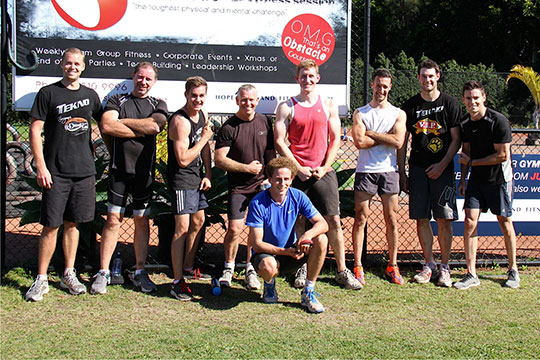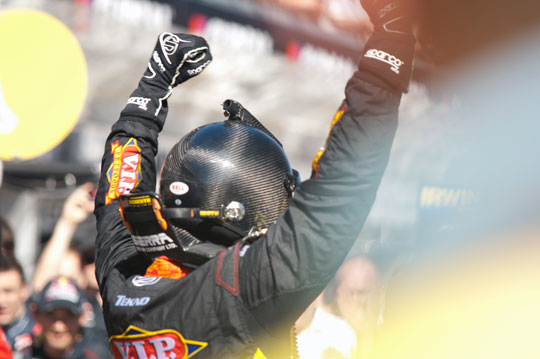
Innovations in aerodynamics, suspension, transmission and new lightweight materials have all made the 2013 new generation V8 Supercar lighter, faster, and more efficient than they have ever been in the category’s history. However, as the technology of the cars has advanced, so too have the physical and mental demands placed on a driver. Just as the teams work to find the optimum set up, the way a driver looks after his own body is fundamental too.
Ayrton Senna put it best in 1992 when he said:
You can drive a Grand Prix car whether you are fit or unfit but for how long you can drive, how precise, how consistent you can drive under stress, under high temperature, the difficult conditions during race is another thing. You know that’s gonna be tough, you know you’re gonna feel tired, gonna have some pain, you’re gonna lose a lot of liquids. But you know you can do it as good as anybody if not better if you are well trained, well fit.
Gone are the days when you’d see drivers in pit lane having a quiet smoke at the back of the pits, munching on a pie and sporting a spare tyre themselves around the middle. Simply having strength isn’t enough to reach the top step of the podium anymore. The level of physical and mental fitness of the drivers needs to be similar to that of many Olympic athletes to cope with a sport that demands they drive hundreds of kilometres over a race weekend. Nutritionists and sports scientists are now a vital cog in improving physical performance not just for the drivers but for pit crew members, mechanics and other team members too.
Ben Nothling, sports scientist at TEKNO Human Performance is one such trainer. Using techniques such as exercise physiology, biomechanics, performance analysis, sports nutrition, sports technology and kinanthropometry (the use of body measurements to understand performance), he works with drivers Jonathon Webb and Shane van Gisbergen to ensure they are in peak physical condition, identifying any areas which may need improvement, assessing and training them as specifically as you would expect a boxer, a rugby player or a rower to be.
Part of the TEKNO Group, which comprises of V8 Supercars team TEKNO Autosports and road car engineering division TEKNO Perfomance, the TEKNO Human Performance Centre is Australia’s first purpose-built motorsport fitness facility. Run by British ex-pat Philip Young, the centre focuses on key health and fitness training for drivers of all ages and categories, as well as for members of the general public. It offers nutritional advice, comprehensive fitness assessments, injury rehabilitation, massage, sport-specific training, hydration advice, general wellness testing and race weekend support packages.
Ahead of the endurance season which brings with it some of the toughest races of the year, V8SCGlobal spoke with Nothling about his role and what makes a V8 Supercar driver fit to race.
V8SCGlobal: What sort of fitness levels do drivers require to help them cope with the demands of a race weekend?
BN: The drivers have to be incredibly fit and strong to be able to cope with the physical demands of driving the race car. It’s only in the last few years that drivers have started to be seen as elite athletes. I think this is a combination of the fact that, firstly, it doesn’t look very strenuous on TV because all you can really see from the in-car footage is the wheel being turned, secondly, with the drivers covered from head to toe you can’t see their exertion, and thirdly, that driving is something that everybody can do with relative ease. By this, I mean that people acknowledge that they can’t kick a football 50 metres straight or bend a free-kick around a wall, but they do drive a car every day and begin to assume that it’s not that hard. With all the modern technology in the cars and with the cars getting faster and faster, the fitness level required to drive the car is really coming to the front of people’s minds, and luckily for the drivers and teams, it’s now widely acknowledged that it’s an important part of success as a race team.
We now know that the drivers’ heart rates hover around 170bpm, which is about 90% of maximum effort, for the duration of their time in the car. Drivers also experience a physiological phenomenon called ‘cardiovascular drift’ which is an unexplained increase in heart rate when the cardiovascular system is placed in prolonged physical activity and heat stress conditions, which can bring fatigue on quicker and really reduce performance.
The drivers also have to contend with the amount of physical strength required to drive the car. The forces required to drive the car are greatly underestimated by the general public. Brake pressure applications are equivalent to approximately an 80-100kg controlled, single-leg leg press with the steering wheel taking approximately 15-20kg to rotate, and G-Forces acting on the head and neck equivalent to 15-20kg of weight being applied. Also needing to be factored in is the amount of isometric force required to hold the driver stable in the seat during acceleration, braking and cornering, as well as dealing with the vibrations being transferred through the seat and into the driver. When completed repetitively over the course of a two-hour driving stint at a circuit such as Adelaide or Bathurst, this equates to an extreme physical load placed on the drivers.
V8SCGlobal: What levels of stress are placed on the body during an event?
BN: Stress and strain placed on the driver during an event are unique to motorsport. The primary physiological stress types that are experienced by the drivers are sustained increased heart rates, sustained muscular effort, increased core body temperature and G-Forces.
The 170bpm heart rate is believed to be due to a combination of the physical effort required to drive the cars, the heat and hormonal responses to the anxiety, anticipation and the competitive nature of motorsport. The sustained muscular efforts of the arms, shoulders, muscles in the trunk and legs means that around a circuit such as Bathurst that has 23 corners, a main driver completing two-thirds of the race distance will turn the wheel over 2400 times, and brake over 950 times.
A V8 driver’s core temperature can increase to up to about 39°C due to the radiant heat from the engine and transmission and the several layers of protective clothing, which is significant because it’s been determined that an increase in body temperature of as little as 0.8°C can have an adverse effect on hand-eye coordination. This increased core temperature, in combination with the muscular effort, leads to excessive sweating and electrolyte loss, as much as one litre an hour.
Even though by international motorsport standards the V8 Supercars have relatively little downforce and grip, the G-Forces experienced by the drivers can still put tremendous strain on their bodies. Over the course of a race, the muscles responsible for handling these forces can become extremely fatigued, and need to be conditioned to withstanding these sustained forces.
V8SCGlobal: Before getting involved with TEKNO Human Performance you worked with A-League football (soccer) team, Brisbane Roar, how does the physical preparation of a V8 Supercar driver differ?
BN: The physical preparation for a V8 Supercar driver is very different. Football is a very explosive sport and requires not only the ability to play for the whole 90 minutes, but be able to sprint, pressure players and defend repeatedly.
Drivers need the strong cardio fitness base to be able to compete at the highest capacity, but their activity requires a lot more strength-endurance, which is the ability to be able to complete a strength action over a long period of time, such as repeated brake pedal applications and turning the steering wheel.
Footballers are also able to practice their sport and skills at any available moment because all they need is a little bit of space and a football, whereas drivers don’t get a chance to drive the cars outside of the limited test days and race weekends, placing great importance on the ability to replicate driving in the training sessions.
V8SCGlobal: When training drivers, do you primarily concentrate on cardio or strength training? Or is it a combination of both?
BN: The drivers do a lot of their own cardio work in the mornings in the form of bike riding. There has been an increase of public knowledge in this lately with drivers tweeting and posting pictures of scenery and coffee joints that they ride through and visit! Because the drivers look after their cardio training, a lot of the gym training that they do with us is strength based.
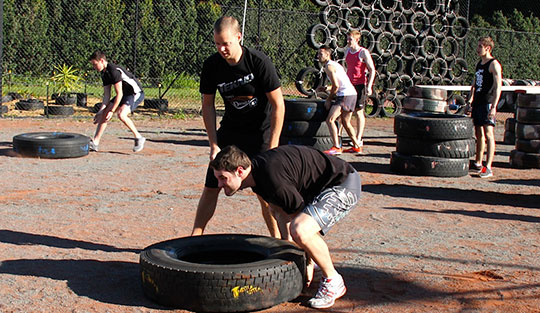
V8SCGlobal: With the endurance races coming up, how does the training schedule differ from sprint races?
BN: The big difference between the sprint races and the endurance races is that the drivers that we train are invited to a motorsport-specific training camp where they will be put through a variety of training sessions and training methods designed to train their entire body and also work on their general overall fitness. The training camp featured activities such as cycling, stand up paddleboarding, rock climbing, tackling an obstacle assault course, a duathlon and a variety of smaller training sessions designed to target the areas required to drive in the endurance races.
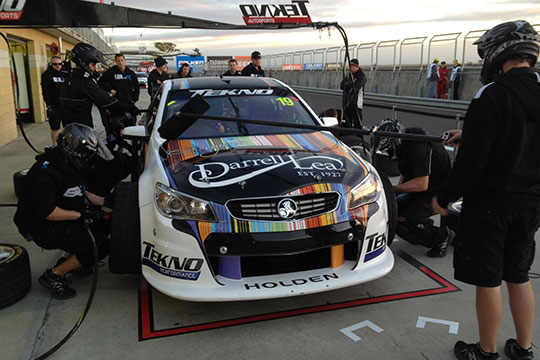
V8SCGlobal: How does the fitness of pit crew, mechanics and other team members come into play?
BN: The fitness of the pit crew, mechanics and other team members can’t be ignored either. Training sessions are available to the pit crew and other team members on a regular basis. The sessions range from individual training to group sessions that not only work on the fitness of the group, but also serve as team-building exercises, boost morale and break up the day for the mechanics if they are working on the cars.
With the 60-60 races and other sprint races this year that don’t feature fuel stops, the emphasis on quick pit stops and tyre changes has never been higher. In previous years, the pit stops have always been determined by the time that it takes to refuel the car, so the pressure was a little bit off the guys because they knew that they had a few seconds up their sleeve if something was to go wrong. However this year, F1-style as-fast-as-possible pit stops are becoming common which means that positions can be won and lost in pit lane. With the pit crew working faster, it means that technique in changing the tyres might not be optimal, which increases the risk of injury. The wheel weighs alot and when you are rotating through the torso to get the old wheel off and get to the new wheel and put it on the hub, the slightest twist the wrong way can really cause injury to the team member. This has an addition impact on the team because a new member needs to be brought into the team and this could affect the pit crew.
Additionally, the team work long hours at the race track during race weekends, meaning that they are susceptible to the aches and pains associated with being on your feet from early in the morning until past midnight some days. Strong core muscles and less reliance on their stomach and back muscles for stability reduces the pain and discomfort involved with these long days.
V8SCGlobal: Could you talk us through a typical nutrition and hydration plan?
BN: Nutrition over a race weekend starts with a low fat, high protein breakfast to provide healthy energy for the morning. The drivers will eat a lunch that is high in protein and carbohydrate, such as pasta or a chicken dish, to provide energy for the afternoon at a time that allows the food to properly digest and not sit in the stomach when they are in the car. Dinner is usually high carbohydrate and designed to replenish the stores of energy within their bodies in preparation for the next day. Healthy snacks such as fruit, nuts or muesli bars are available for snacking on during the day if they get hungry.
Hydration is a huge part of preparation and one of the few things that we can manipulate to improve performance at a race weekend, but must be organised to not cause any issues during the day. By keeping the drivers adequately hydrated, we can ensure that their performance is sustained as long as possible in the car and also that their hydration levels don’t drop to levels that can be detrimental to their health and wellbeing. The drivers always have an electrolyte drink with them to ensure that their hydration levels are at the optimum level throughout the day.
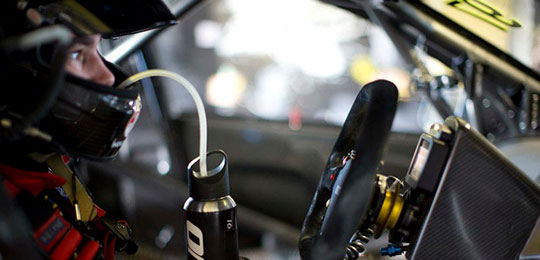
Being adequately hydrated not only ensures that performance quality isn’t reduced, but also avoids health issues such as discomfort, fatigue, concentration loss and nausea. The drivers can expect to lose approximately one litre of fluid for every hour that they are in the car, so this is monitored following a session to ensure that the fluids are properly replaced. Fluid is replaced constantly rather than in short, sharp quantities to prevent hyponatraemia, which is dilution of electrolytes caused by over-hydration. The drinks are specially prepared to be hypotonic, which allows the fluid to be rapidly absorbed back into their systems.
V8SCGlobal: Pre-event, what do you feel is more important to maintaining peak performance, mental or physical health?
BN: Both are equally as important as the other. The driver can be in 100% peak physical condition, but if their head is not in the right space, they won’t be able to perform in the car. Conversely, if they aren’t 100% physically capable, their performance will suffer. People underestimate the sort of mental stresses that a driver goes through, both on track and off track, such as performance requirements and pressure from the media or possibly even from within their own team, and any sort of distractions or lack of desire to perform can make a huge impact, but also put their safety at risk in the event of an accident.
V8SCGlobal: How do you help a driver combat mental fatigue and his ability to concentrate for long periods of time?
BN: Believe it or not, improving a driver’s physical fitness actually combats mental fatigue. If a driver is sitting in the car during a race and thinking about how tired they are, or how much their back hurts, or how hot it is in the cabin or about anything else like that, it takes away their focus from what they’re doing, and reduces their performance. There have also been studies completed that show that increased physical fitness, specifically endurance training, also decreases the strain of human beings during psycho-emotional-concentrative stress situations, such as those experienced during motorsport, and increases the mental performance capacity as well as stress tolerance, which is major factor in the race car.
We also do a lot of concentration training under fatigue situations. For example, it might be something as simple as making the driver complete an action that replicates turning the steering wheel, and then completing a concentration and reaction time exercise when they are fatigued. Over time, the drivers improve their ability to concentrate and react when they are fatigued. This sort of training, combined with the increased physical fitness and keeping the driver hydrated all help to combat mental fatigue and improve concentration.
V8SCGlobal: Post-race, how do drivers recover?
BN: The recovery process that the drivers go through depends on the format of the race weekend and also the weather conditions of the race weekend. As soon as the drivers get out of the car, they are provided with a customised rehydration fluid designed to replenish fluid weight lost in the car and also electrolytes that are lost through sweating during the race session. As soon as possible, sometimes following any commitments that the drivers might have with podium celebrations and media, the drivers are placed into a cold-water bath to help bring the core temperature of the drivers back down to normal and also given a recovery shake consisting of a protein powder that also has a carbohydrate component to assist with replenishing muscle fuel stores and repairing any routine muscle microtrauma with a banana mixed in to assist with potassium intake and flavour! This is also useful because it might be a while before the drivers are able to eat dinner following a race.
V8SCGlobal: How about between stints at Bathurst, what do drivers do to ensure they recover and keep physically ready for the next session?
BN: The recovery between Bathurst stints is much the same as a post-event recovery or even a post-race recovery on a sprint race weekend. The driver is placed into a cold water bath to reduce their core body temperature back to normal, provided with enough electrolyte drink to replace the fluid and electrolytes lost during the stint and depending on how long they have until they are scheduled to next be in the car, they will either have something light to eat or have their recovery protein shake. All this recovery takes place after they’ve debriefed with their engineer and started to rehydrate in the garage. If the driver is feeling tight a massage will take place as well before they start to relax and recover mentally prior to the next stint in the car. It’s important for the driver to relax between stints because they’ve been focused and mentally overloaded for the duration of their stint, so they need to take time to calm back down before it’s required that they refocus again.
V8SCGlobal: When does the physical preparation begin for the next event?
BN: The drivers usually have a few days of rest or light training to recover from any niggles that they might have picked up over the weekend, and then preparation starts for the next event. However, this changes depending on how long there is until the next race weekend, when they return from fly-away races, and if there are commitments within the team or sponsorship and corporate partner commitments.
V8SCGlobal: Are there any common injuries that drivers suffer?
BN: Luckily due to the safety innovations involved in modern motorsport, there aren’t too many injuries that are common. Obviously in the event of a crash, there are all sorts of possible injuries to contend with, but we incorporate injury prevention into the drivers’ training programs to ensure that everything possible has been done to minimise injury risk. Flexibility training is carried out to increase the range of motion of the drivers’ bodies, and this ensures that they have a ‘buffer zone’ in terms of movement, meaning that if they do have an accident and they get flung around inside the car, they aren’t being overextended and damaging ligaments and tendons around their joints.
V8SCGlobal: Are there any bad habits that drivers have that you try to steer them away from?
BN: Like all of the elite athletes that I’ve worked with, the drivers understand the importance of their training and understand that any misdemeanours or bad habits will negatively affect their performance when it matters, so their discipline is pretty professional. With the way the V8 calendar works, there are several opportunities to take time away from the Australian series and take a few days or a week holiday or head overseas and race in other categories such as drifting or the NZ series, so there are plenty of opportunities for their eating to not be as ideal as we’d like. As I stated before though, the drivers understand what needs to be done so their nutritional misdemeanours are still pretty good!
